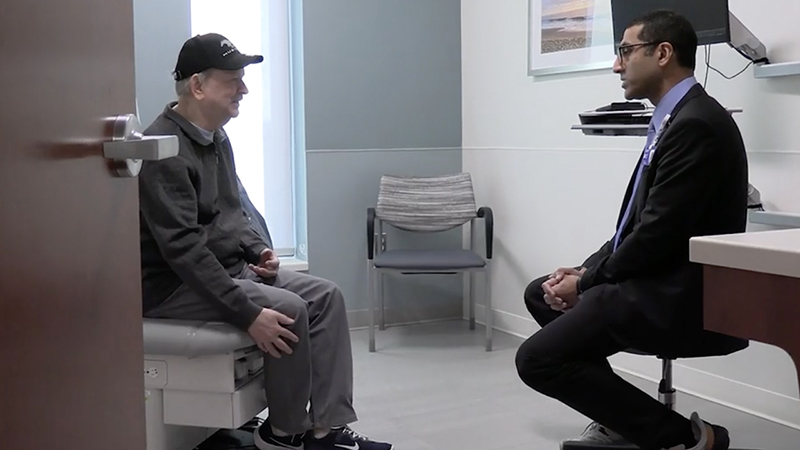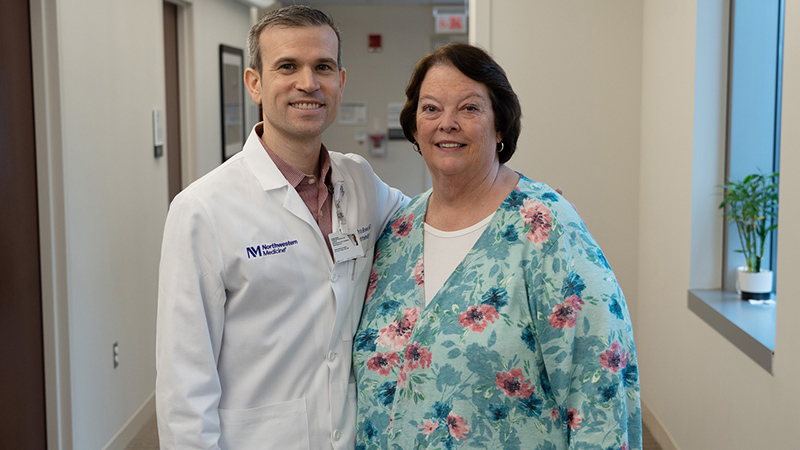
Radiation Oncology
We’re dedicated to making sure you get leading-edge, compassionate cancer care grounded in precision, innovation and collaboration. Combining advanced technology with expert care, we work to tailor your care to your unique needs while minimizing side effects.
The Northwestern Medicine Department of Radiation Oncology is a world-class cancer care program, offering innovative radiation therapy. Our multi-specialty teams work together to ensure you get the best possible care.
Why Choose Us for Radiation Therapy?
Our patients are at the center of their care team. Here, you can benefit from:
- Care from nationally recognized experts in radiation cancer care
- Access to clinical trials for innovative treatments that aren’t widely available yet
- Advanced technologies that improve accuracy and minimize side effects, including:
- AI-powered tools that help identify and outline tumor areas
- Tailored dose planning
- Adaptive radiation guided by real-time MRI
- Treatment plans informed by tumor board meetings of leading experts from different specialties working together
- Support at every step of your cancer journey with support services, nurse navigators and survivorship planning
- Locations across the Chicago area so you can enjoy more convenience and a smoother care journey
Meet the Teams

Understanding Radiation Therapy
Radiation therapy is a cornerstone of modern cancer care. It uses high energy rays to destroy cancer cells or prevent them from multiplying. Radiation damages the DNA of cancer cells more than healthy cells, killing them. The goal is to target the tumor and avoid noncancerous tissues.
For treatment, you may only receive radiation, or it may be combined with other treatments like surgery, chemotherapy and immunotherapy. Your care plan will depend on the type of cancer, its stage and its location.
Learn about the types of radiation therapy:
- External beam radiation therapy (EBRT)
- Internal radiation therapy (brachytherapy)
- Systemic radiation therapy
What to Expect Before and During Treatment
- Consultation visit: Your first visit will be a consultation with a radiation oncologist. They will review your medical history, imaging scans and biopsy results to determine if radiation is right for you.
- Planning (simulation) visit: We will use imaging scans to create a precise treatment plan tailored to your tumor’s size and location. You may get small skin marks to help us place the radiation machine. We may make you a custom mask or body mold to help you stay still during radiation.
- Treatment visits: Most sessions are painless and last 15 to 30 minutes. During these visits, you’ll lie still on a treatment table while the machine delivers radiation. You will not feel or see the radiation.
- Ongoing care visits: Your care team will monitor your progress and manage any side effects throughout treatment. After you finish treatment, we will coordinate your care with the rest of your cancer team.
Managing Side Effects and Recovery
Most people tolerate radiation well. However, you may have side effects. Most side effects are manageable and temporary. We will support you with guidance and medications as needed.
Radiation Safety
Our team members are specially trained in how to safely deliver radiation. They have experience and expertise in this area, and they can answer any questions you have.
External radiation does not make you radioactive. Internal and systemic radiation is radiation that goes into or through your body. For internal and systemic radiation, we may:
- Ask you to follow temporary safety precautions
- Limit visitors to your home, especially young children or pregnant people
Clinical Trials and Research
Northwestern Medicine relentlessly pursues better cancer care. Through an ever-evolving roster of promising clinical trials, we give you access to breakthrough treatments and medications — along with innovative ways to use existing therapies — that are shaping the future of medicine.
View our current clinical trials and search for ones that offer radiation treatments.
Conditions treated
Radiation therapy may be used for treatment of:
- Anal Cancer
- Bladder Cancer
- Brain Tumors
- Breast Cancer
- Cervical Cancer
- Colorectal Cancer
- Dupuytren's Contracture
- Esophageal Cancer
- Eye Cancer
- Gastric Cancer
- Head and Neck Cancers
- Kidney Cancer
- Leukemia
- Liver Cancer
- Lung Cancer
- Lymphoma
- Multiple Myeloma
- Pediatric Cancer and Blood Diseases
- Prostate Cancer
- Sarcoma
- Skin Cancer
- Uterine Cancer
Radiation therapies
At Northwestern Medicine, radiation therapy is tailored to your diagnosis and goals. Your care team will discuss which options fit your situation, what to expect day to day, and how we minimize effects on healthy tissue.
- 3-D Conformal Radiation Therapy
- Deep Inspiratory Breath-Hold
- Gamma Knife® Radiosurgery
- High-Dose-Rate (HDR) Brachytherapy
- Hyperthermia Therapy
- Image-Guided Radiation Therapy (IGRT)
- Intensity Modulated Radiation Therapy
- Intraoperative Radiation Therapy (IORT) for Breast Cancer
- Low-Dose Brachytherapy
- Proton Therapy
- Stereotactic Body Radiation Therapy (SBRT)
- Stereotactic Radiosurgery
- Theranostics
- TomoTherapy
- Total Body Irradiation (TBI)
- Volumetric Modulated Arc Therapy (VMAT)
Contact Radiation Oncology
To contact a radiation oncology location near you, please refer to the Locations & Contact Information below for locations, phone numbers and map.





